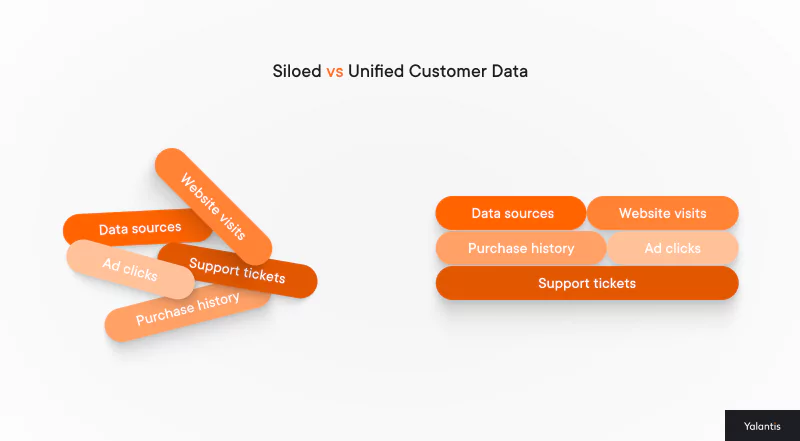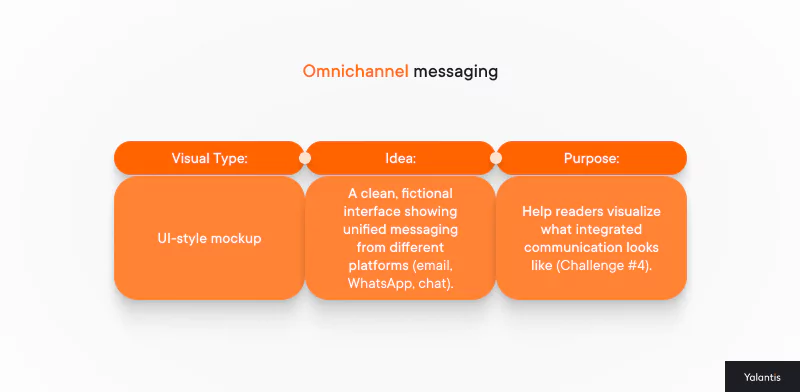
6 business challenges you can solve with a deeper view of your user data
Summarize:
In 2025, failing to analyze user data — or paying insufficient attention to it — is no longer just an oversight – it’s a serious threat to business survival. Poor understanding of user behavior causes businesses to operate blindly, making decisions based on guesswork rather than concrete insights.
Working with 360-degree analysis of user data becomes an operational necessity. The vast majority of customer interactions, whether digital or physical, generate valuable data points that, when properly analyzed, reveal powerful patterns, behaviors, and opportunities.
The technology to extract, analyze, and act on this data is readily available. In this article, we will go through how a 360-degree view on your user data can help you solve critical business challenges by exploring Yalantis and Bird’s success stories.
Need a better dialogue with your data? Let Yalantis help build it!
Book a callChallenge #1: Managing isolated customer data
According to a Harvard Business Review, 83% of businesses struggle with siloed customer data, stored across multiple, disconnected systems. This fragmentation makes it nearly impossible to gain a comprehensive understanding of customer interactions, leading to a lack of personalized engagement and lost business opportunities. When data remains scattered across different platforms, teams face difficulties in:
- tracking customer behavior
- identifying preferences
- predicting future needs
Marketing campaigns, customer service interactions, and sales strategies all suffer when decisions are based on incomplete or outdated information.
A more efficient approach involves integrating disparate data sources into a unified system, where customer interactions from various touchpoints—such as website visits, support tickets, and purchase histories—can be consolidated and analyzed holistically. Companies use customer data platforms and advanced data management to create detailed customer profiles, enhance engagement, and ensure accurate, automated, and accessible data.

Companies in real estate and e-commerce, for example, have seen notable improvements in their ability to create personalized experiences by leveraging such a consolidated approach to data. Bird’s Customer Data Platform (CDP) integrates data from multiple sources, offering a 360-degree view of each customer. This unified data approach enables businesses to tailor their interactions based on customer behaviors and preferences.
As an example, take a look at how Zillow leveraged Bird’s CDP to unify customer data across different touchpoints, resulting in a 161% email open rate growth, as well as more effective, data-driven marketing campaigns. We at Yalantis also did a similar job for Lifeworks, when we developed the unified system for handling multiple wealth operations, that also helped to scale this business.
Challenge #2: Inefficient and time-consuming marketing efforts
One of the biggest hurdles enterprise businesses face is the inefficiency of their marketing campaigns. Without a deep understanding of audience segmentation and behavior, businesses resort to broad messaging that lacks precision. Traditional marketing efforts often rely on manual campaign management, which is both time-consuming and prone to human error. Without automation and advanced segmentation, enterprises fail to engage customers effectively, resulting in low conversion rates and wasted resources.
Implementing customer segmentation tools and behavioral insights already helped multiple businesses optimize their marketing efforts. Analyzing customer interactions and preferences helps to create targeted campaigns that are more likely to resonate with specific audience segments. Automated marketing workflows can:
- streamline customer analysis in various domains
- maintain consistent communication with customers
- reduce the manual effort.

For instance, agricultural B2B companies have benefited significantly from marketing automation, seeing higher engagement rates through personalized content and well-timed outreach efforts. That’s exactly what Swiss agricultural giant Syngenta did when they used Bird’s platform to fine-tune their marketing efforts for farmers, which resulted in a 35% increase in engagement for WhatsApp and SMS channels.
Challenge #3: Lack of workflow automation
Manual processes are still widely used for handling customer interactions, operational workflows, and administrative tasks. Having too much repetitive work slows down people’s performance and increases the risks of man-made mistakes. In industries where quick responses and timely actions are crucial, for example, in healthcare or complex logistics, the inability to automate workflow processes can lead to delays, frustrated customers, and lost revenue opportunities.
Modern solutions, often including AI-powered ones, can now:
- handle routine inquiries
- process large volumes of requests
- ensure workflows run smoothly with minimal human oversight
Embracing automation helped thousands of companies see remarkable improvements in productivity and efficiency. From email responses and customer support interactions to sales follow-ups and data entry, automation reduces the burden on teams, allowing them to focus on higher-value activities. For instance, one of Brid’s partners—Propseller—has successfully reduced administrative overhead by implementing automation tools that streamline operations and free up their teams to focus on strategic tasks, which resulted in a 250% increase in sales conversions.
Workflow automation is also crucial for logistics, where unnecessary slowdowns may cost a fortune. As an example, we at Yalantis helped a US-based logistics company develop an automated cloud-based transportation management system, which helped cut operational time and solve issues automatically.
If you’re wondering how your exact business might profit from automation and AI integration, check out Yalantis’ whitepaper on AI strategy for established businesses.
Challenge #4: Managing multi-channel customer communication
With customers engaging across multiple platforms—including email, social media, live chat, and messaging apps—businesses must ensure that communication remains seamless and consistent. However, managing these various channels manually is often overwhelming, leading to fragmented interactions, inconsistent messaging, and a lack of coordination between departments. Customers expect immediate and relevant responses, and failing to provide them can result in lost trust and disengagement.

Organizations that have successfully integrated their communication channels into a unified system have been able to improve response times, create cohesive messaging strategies, and gain better insights into customer interactions. By consolidating all customer conversations in a single platform, businesses can track engagement more effectively and ensure that interactions are timely and personalized. Yoco, a South African fintech company, for example, adopted multi-channel communication platforms to unify messaging across different touchpoints, resulting in decreasing human chat interactions and a 73 customer satisfaction score for chat.
Challenge #5: Limited access to actionable data insights
Having extensive amounts of data is useless if a business cannot extract meaningful insights from it. Many companies struggle with interpreting data effectively, leading to slow decision-making, ineffective marketing strategies, and operational inefficiencies. Without real-time analytics and advanced reporting capabilities, businesses operate reactively rather than proactively, often missing opportunities to optimize their strategies.
Companies that embrace real-time data analytics have gained a competitive advantage by making informed decisions based on up-to-the-minute insights. Advanced analytics platforms provide businesses with clear visualizations of customer trends, campaign performance, and operational bottlenecks, allowing them to pivot strategies quickly when needed. In industries such as finance and retail, leveraging AI-driven analytics has led to:
- better customer targeting
- optimized resource allocation
- more efficient business operations
This worked great for Binance when they decided to expand their reach via marketing emails. As a result, Binance got 2/5x email growth and the amount of emails sent increased to 150+ million emails per week.
Challenge #6: Scaling customer engagement as businesses grow
As businesses expand, maintaining personalized interactions with customers becomes increasingly challenging. Many organizations struggle to balance growth with customer retention, as larger customer bases demand more complex engagement strategies. Scaling engagement while preserving a high level of personalization is a major challenge for fast-growing companies.
Implementing scalable customer engagement platforms helps businesses continue to provide meaningful interactions with customers while optimizing resources. AI-driven automation, intelligent segmentation, and predictive analytics allow businesses to anticipate customer needs and deliver personalized experiences at scale.
In particular, SuperVista, a successful eyewear company, has addressed this challenge by adopting scalable engagement strategies that ensure customers feel valued even as the business grows—in SuperVista’s case, this is reflected in a 200% increase in leads.
Conclusion: a strategic approach to customer engagement and digital transformation
Businesses that leverage data effectively and optimize customer engagement strategies have much better chances of attracting more clients and revenue. A strategic, technology-driven approach ensures long-term success by transforming customer engagement, data analysis, and operational workflows.
- Unify customer data for better decision-making: A fragmented data ecosystem can result in inconsistent customer experiences and poor decision-making. By consolidating customer data from all touchpoints into a single, structured database, businesses can create comprehensive user profiles. This approach enables companies to analyze customer behaviors holistically and make informed strategic decisions that improve conversion rates and long-term customer retention.
- Automate repetitive processes to improve efficiency: Manual processes slow down operations and increase the risk of human error. Automation tools streamline repetitive tasks such as customer follow-ups, order processing, and response handling, freeing up valuable human resources. This not only enhances productivity but also ensures consistency in customer interactions, leading to a more efficient and scalable business model.
- Enhance marketing effectiveness through targeted campaigns: Generic, one-size-fits-all marketing campaigns are increasingly ineffective. By leveraging AI-driven segmentation and predictive analytics, businesses can create hyper-personalized marketing strategies that resonate with different audience segments. Targeted campaigns improve customer engagement, boost ROI, and strengthen brand loyalty.
- Optimize multi-channel communication for seamless customer interactions: Modern consumers expect seamless interactions across multiple channels. A unified communication strategy enables businesses to integrate social media, email, chatbots, and traditional support channels into one platform. This ensures that customer interactions remain consistent, timely, and relevant, improving overall customer satisfaction.
- Leverage real-time analytics for data-driven strategies: Businesses must shift from reactive to proactive decision-making by harnessing real-time analytics. Advanced dashboards and AI-powered insights allow companies to track customer behavior in real time, measure campaign performance, and identify trends before they impact business outcomes. This agility ensures businesses can quickly adapt their strategies to changing market conditions.
- Scale customer engagement efforts without losing personalization: Growth often brings operational complexities that can dilute customer experience. Scalable engagement platforms powered by automation and AI ensure that businesses can maintain a personalized approach even as they expand. By segmenting customers based on their interactions and preferences, businesses can continue to deliver customized experiences at scale, fostering long-term customer loyalty and revenue growth.
Your data could tell you more! Let us show you how.
Book a callRate this article
4.9/5.0
based on 16 reviews





